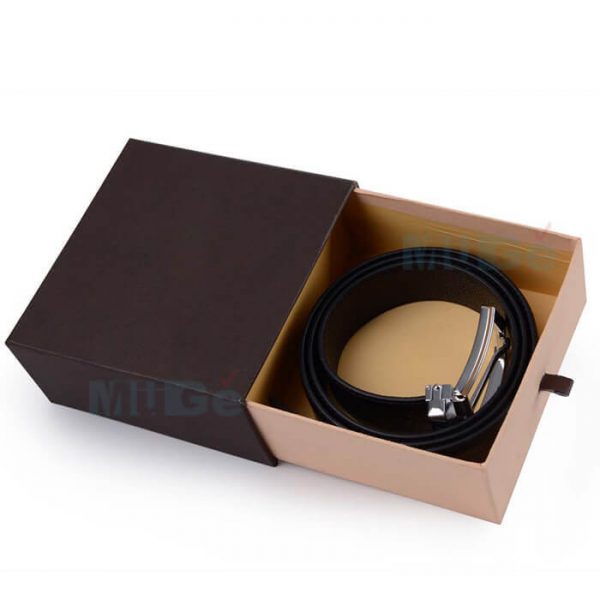
In the fashion industry, presentation is as crucial as the product itself. For accessories like belts, packaging serves not only as a protective measure but also as an essential element in enhancing brand perception and consumer experience. This article delves into the multifaceted world of belt packaging, exploring its importance, various types, design considerations, and the impact of sustainable practices.
The Importance of Belt Packaging
Belt packaging plays a pivotal role in the retail and e-commerce sectors. It protects the product during transit and storage, ensuring that it reaches the customer in pristine condition. A well-designed packaging can also add value to the product, making it more appealing and justifying a higher price point. Additionally, it serves as a canvas for brand messaging, helping to convey the identity and ethos of the company.
Types of Belt Packaging
1. Cardboard Boxes
Cardboard boxes are a popular choice for belt packaging due to their versatility and durability. They can be easily customized with various printing techniques to showcase the brand logo, product information, and attractive graphics. These boxes often include internal supports to keep the belt secure and prevent it from shifting during transit.
2. Rigid Boxes
Rigid boxes offer a premium feel and are often used for high-end belts. Made from sturdy materials, these boxes provide excellent protection and can be designed with intricate details like magnetic closures, embossing, and foil stamping. The luxurious look and feel of rigid boxes enhance the unboxing experience, making it memorable for the customer.
3. Sleeve Packaging
Sleeve packaging consists of a cardboard or paper sleeve that wraps around the belt. This minimalist approach is cost-effective and allows for easy customization. Sleeve packaging is ideal for showcasing belts in retail settings, as it provides a clear view of the product while still offering some level of protection.
4. Fabric Pouches
Fabric pouches add an element of sophistication to belt packaging. Made from materials like cotton, velvet, or satin, these pouches offer a soft, protective layer for the belt. They are particularly popular for gifting purposes and can be reused by customers, enhancing brand recall.
5. Plastic Packaging
While less environmentally friendly, plastic packaging is still used for its cost-effectiveness and durability. Clear plastic boxes or blister packs allow customers to see the product without opening the package, which can be beneficial in retail environments. However, brands are increasingly moving away from plastic due to environmental concerns.
If you want to know more about ” shoe packaging boxes wholesale ” visit topusapackaging
Design Considerations for Belt Packaging
1. Brand Identity
The packaging should reflect the brand’s identity and values. Luxury brands might opt for high-end materials and sophisticated designs, while eco-friendly brands might choose recyclable materials and minimalist designs. Consistency in branding across all packaging elements helps build brand recognition and loyalty.
2. Functionality
Packaging should not only look good but also be functional. It should protect the belt from damage, be easy to open, and ideally, be reusable or recyclable. Including features like a window to display the belt or compartments for additional accessories can enhance functionality.
3. Customer Experience
The unboxing experience is a critical aspect of modern packaging design. A well-thought-out unboxing experience can leave a lasting impression on the customer, encouraging repeat purchases and positive word-of-mouth. Elements like elegant closures, personalized notes, and thoughtful design details can significantly enhance this experience.
4. Sustainability
With growing awareness about environmental issues, sustainability has become a key consideration in packaging design. Brands are increasingly using eco-friendly materials, reducing packaging waste, and opting for biodegradable or recyclable options. Sustainable packaging not only appeals to environmentally conscious consumers but also helps brands reduce their carbon footprint.
Impact of Sustainable Practices
Sustainability in packaging is more than just a trend; it is a necessity in today’s world. The fashion industry is one of the largest polluters, and packaging contributes significantly to this problem. By adopting sustainable practices, brands can make a positive impact on the environment while also appealing to a growing demographic of eco-conscious consumers.
1. Material Selection
Choosing sustainable materials like recycled cardboard, biodegradable plastics, or organic fabrics can significantly reduce the environmental impact of packaging. These materials often require less energy to produce and result in lower carbon emissions.
2. Reducing Waste
Designing packaging that uses less material without compromising on protection can help reduce waste. Brands can also encourage customers to recycle or repurpose packaging by providing clear instructions and highlighting the recyclability of the materials used.
3. Innovation in Design
Innovative design solutions can make packaging more sustainable. For example, modular packaging that can be easily disassembled for recycling or multifunctional packaging that can be repurposed by the customer can significantly reduce waste.
Conclusion
Belt packaging is an integral part of the product’s overall presentation and plays a crucial role in protecting the product, enhancing brand perception, and providing a memorable customer experience. As the industry moves towards more sustainable practices, innovative and eco-friendly packaging solutions are becoming increasingly important. By carefully considering design elements, material selection, and functionality, brands can create packaging that not only stands out but also aligns with the values of today’s consumers.